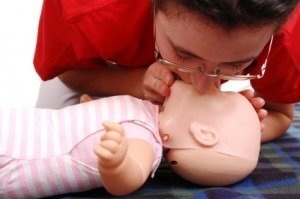[heading style=”1″]Being Prepared and Being a Good Parent: Infant First Aid and CPR will help you achieve that goal.[/heading]

There are a number of responsibilities that come with parenthood. To put it simply, to love and cherish your children is no longer enough to be called a good parent. A parent also needs to keep them close and protect them.
Seeing as how we all live in today’s world, increasingly unpredictable and dangerous, it is important that parents do everything they can to protect their kids. There are so many things that can happen. It is difficult to call a place ‘safe’ once you know that emergency situations can virtually develop anywhere. Your children are at risk even in the places where you feel the safest.
Of course, constantly living in fear is essentially counterproductive. All parents should have the basic first aid training so that they are able to administer emergency procedures such as CPR (Cardiopulmonary Resuscitation) if the need ever arises. Being prepared for emergency situations is the only way a parent can do if they are truly serious about taking care of their children. Continue reading and learn more about infant vs child CPR.
[note color=”#2d89b1″]Common Emergency Situations Involving Children[/note]
Most emergency situations involving children that entail the performance of CPR are categorized as either caused by accidents or as caused by health conditions. For instance, one of the most common accidents would be falling from high places. This could cause severe head trauma, loss of consciousness, or even death. Drowning is another common accident for children; it can happen in public spaces like the pool or in the house tub. Cases of poisoning also rank high on this list, with the child accidentally ingesting dangerous substances.
Health conditions such as extreme asthma attacks and the onset of Sudden Infant Death Syndrome also entail the application of emergency procedures like CPR.
Watch this First aid – Baby CPR from the British workplace approved
[media url=”http://www.youtube.com/watch?v=hOtvVIB8ULo” width=”600″ height=”400″][note color=”#2d89b1″]Administering CPR to Infants[/note]
It’s crucial for parents to know that there is a difference between regular CPR and infant CPR. You can learn about such things by attending a CPR Training course. Ignorance of such things can often lead to worse situations for your child. While the basic concepts remain intact,the procedures vary in terms of how the chest compressions are applied. This is for you to know how to do infant CPR.
Parents only need to make use of their fingers when compressing the infant’s chest. Two fingers are placed below the infant’s nipples, right in the middle of their chest. You need to make sure that the chest sinks by 1/3 of its depth whenever you perform the compressions. The rate of chest compressions is still the same with that of adult CPR. This means that you should do 100 chest pumps per minute.
[note color=”#2d89b1″]What to Do During an Emergency[/note]
A swift response time is what ultimately separates life and death. Contacting emergency response services is one of the first things you should do once the dangers of the situation has been recognized. In the meantime, parents should not sit idly by as they wait for the arrival of emergency help. There is always the possibility that medical professionals and emergency workers may arrive a little later than expected.
As you wait for their arrival, you should go ahead and do the necessary emergency procedures you have learned from the First Aid classes.
